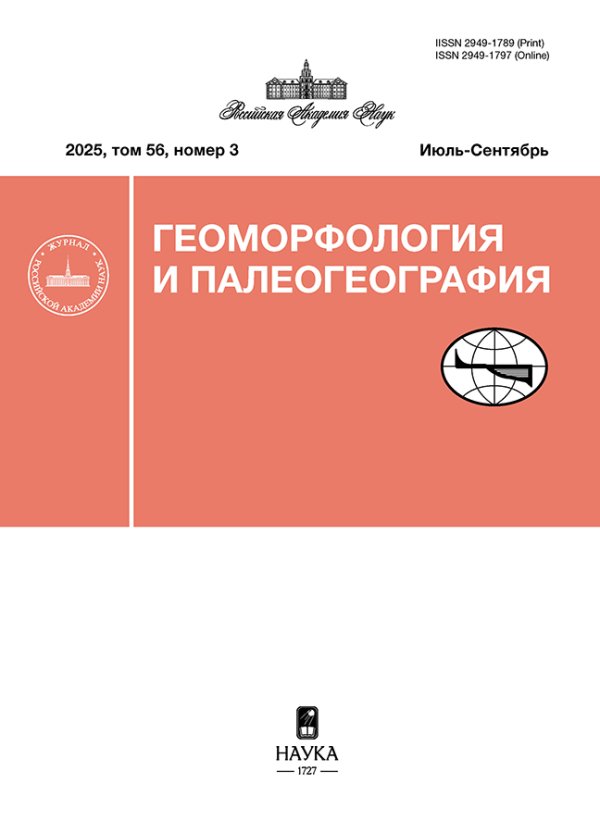РАЗВИТИЕ ЭВОРЗИОННЫХ АНАЛОГОВ СКЭБЛЕНДОВ В НИЖНЕМ БЬЕФЕ ОДНОЙ ИЗ КАРЕЛЬСКИХ ГЭС
- Авторы: Лукашов А.А.1, Смоктунович Т.Л.2
-
Учреждения:
- Московский государственный университет имени М.В. Ломоносова, географический факультет
- Московский педагогический государственный университет, географический факультет
- Выпуск: Том 54, № 2 (2023)
- Страницы: 3-13
- Раздел: Региональная геоморфология
- URL: https://journals.rcsi.science/2949-1789/article/view/139447
- DOI: https://doi.org/10.31857/S2949178923020068
- EDN: https://elibrary.ru/ECMBDJ
- ID: 139447
Цитировать
Полный текст
Аннотация
Реки Карелии отличаются геологической молодостью, оформившись как флювиальные комплексы лишь в голоцене. Малый возраст в сочетании с прочностью кристаллических пород Балтийского щита обусловили невыработанность их продольного профиля. В основании порогов местами развиваются процессы формирования миниатюрных скэблендов. Подобная гидравлическая ситуация складывалась и у фронта деградирующего ледника. Благоприятны для мощного воздействия на скальное ложе также нижние бьефы плотин ГЭС. На осушенных в ходе гидротехнического освоения отрезках скального ложа полугорных потоков можно встретить следы бурной глубинной эрозии, сопровождавшейся явлениями неизбирательной эворзии и гидродинамической кавитации. Показателен миниатюрный скэбленд, выработанный в нижней части крупного порога Маткожня на реке Нижний Выг в зоне Беломорско-Балтийского канала. Почти вся трасса канала проложена по долине этой реки, лишь на отдельных отрезках между шлюзами русло канала пробито в стороне, поэтому там сохранилась почти обезвоженная прежняя долина. Коренные породы обнажаются здесь по всему руслу; многочисленны стаканоподобные формы микрорельефа диаметром и глубиной до первых метров в кристаллических породах докембрия. Вклад эворзии в денудацию кристаллических сланцев в днище долины Выга является весьма значимым, хотя само эворзионно-кавитационное воздействие осуществляется редко и в течение ограниченного времени. Подобные процессы естественного происхождения действовали до создания водохранилищ на порожисто-водопадных участках как в долине Выга, так и других крупных рек Карелии. Аварийные спуски воды через высокие водосливные плотины могли усиливать разрушительное воздействие потока на его коренное ложе. Образование эворзионных микроформ у порога Маткожня является частично техногенно обусловленным. Карельские кавитационно-эворзионные комплексы форм могут рассматриваться как миниатюрные аналоги гигантских позднеплейстоценовых скэблендов северо-запада США, Скандинавии, Алтая.
Об авторах
А. А. Лукашов
Московский государственный университет имени М.В. Ломоносова, географический факультет
Автор, ответственный за переписку.
Email: smoluk@yandex.ru
Россия, Москва
Т. Л. Смоктунович
Московский педагогический государственный университет, географический факультет
Email: smoluk@yandex.ru
Россия, Москва
Список литературы
- Беркович К.М. (2004). Антропогенные изменения русловых процессов // География, общество, окружающая среда. Том VI. Динамика и взаимодействие атмосферы и гидросферы. М.: Городец, С. 486–493.
- Величко А.А., Фаустова М.А., Писарева В.В., Карпухина Н.В. (2015). Реконструкция ландшафтов, формировавшихся на окраине Скандинавского ледникового покрова в период его деградации (в интервале от максимума похолодания до начала голоцена) // Актуальные проблемы палеогеографии и стратиграфии плейстоцена: Материалы Всероссийской научной конференции “Марковские чтения 2015 года”. М.: Географический факультет МГУ, С. 49–51.
- Виноградова Н.Н., Чалов Р.С. (2004). Горные реки и реки в горах: продольный профиль, морфология и динамика русел // География, общество, окружающая среда. Том VI. Динамика и взаимодействие атмосферы и гидросферы. М.: Городец, С. 460–469.
- Воскресенский С.С. (1968). Геоморфология СССР. М.: Высшая школа, 368 с.
- Евзеров В.Я. (2020). Основные события эволюции поздневалдацского оледенения в Карело-Кольском регионе с дополнением к ранее опубликованным данным о мощностях строительных материалов // Вестник Кольского научного центра РАН. № 1. С. 26–33. https://doi.org/10.37614/2307-5228.2020.12.1.003
- Карасев И.Ф. (1970). Русловые процессы при переброске стока. Л.: Гидрометеоиздат, 268 с.
- Квасов Д.Д. (1976). Происхождение котловины Онежского озера // Палеолимнология Онежского озера. Л.: Наука, С. 7–40.
- Кнэлл Р., Дейли Дж., Хэммит Ф. (1974). Кавитация. М.: Мир, 678 с.
- Лобанова Н.В. (2015). Петроглифы в низовьях р. Выг: проблемы хронологии и периодизации // Российская археология. № 4. С. 16–33.
- Лукашов А.Д. (1976). Новейшая история Карелии. Л.: Наука, 109 с.
- Райс Р.Дж. (1980). Основы геоморфологии. М.: Прогресс, 576 с.
- Ранний докембрий Балтийского щита / В.А. Глебовицкий. (2005). СПб: Наука, 711 с.
- Рудой А.Н. (1994). Скейбленд Центральной Азии // Природа. № 8. С. 3–20.
- Рудой А.Н. (2005). Гигантская рябь течения (история исследований, диагностика, палеогеографическое значение). Томск: Изд-во ТГПУ, 224 с.
- Рыбалко А.Е., Токарев М.Ю., Семенова П.Р. и др. (2018). История формирования Беломорской котловины и четвертичного покрова Белого моря по данным геологического картирования // Мат-лы Всерос. науч. конф. “Поздне- и постгляциальная история Белого моря: геология, тектоника, седиментационные обстановки, хронология”: сборник статей. М.: КДУ, Университетская книга, С. 141–146.
- Самойлов А.Е. (2003). Канал // Капитан-клуб. № 1. С. 116–119.
- Север Европейской части СССР. (1966). М.: Наука, 452 с.
- Спиридонов А.И. (1978). Геоморфология европейской части СССР. М.: Высшая школа, 332 с.
- Субетто Д.А., Потахин М.С., Зобков М.Б. и др. (2019). Развитие Онежского озера в позднеледниковье по трезультатам ГИС-моделирования // Геоморфология. № 3. С. 83–90. https://doi.org/10.31857/S0435-42812019383-90
- Терве – Путешествие по Финляндии [Электронный ресурс]. URL: https://terve.su/ispolinskie-kotly-v-finlyandii (дата обращения: 01.08.2022)
- Толковый словарь английских геологических терминов. Том. 2 / Дж. А. Джексон. (2002). М.: МЦГК “Геокарт”, ГЕОС, 637 с.
- Хольтедаль У. (1958). Геология Норвегии. Том II. М.: Изд-во иностранной литературы, 395 с.
- Чалов Р.С. (2019). Русловедение: теория, география, практика. Т. 3: Антропогенные воздействия, опасные проявления и управление русловыми процессами. М.: Красанд, 640 с.
- Чеботарев А.И. (1978). Гидрологический словарь. Л.: Гидрометеоиздат, 308 с.
- Щукин И.С. (1980). Четырехъязычный энциклопедический словарь терминов по физической географии. М.: Советская энциклопедия, 703 с.
- Bourke M.C. (2006). Scabland // Encyclopedia of Geomorphology (Ed. Goude A.S.). Routledge, P. 912–914.
- Bretz J.H. (1923). The channeled scablands of the Columbia Plateau // Journal of Geology. Vol. 31. No. 8. P. 617–649.
- Magee K. (1996). From the Scabland to Mars: Preparing for the Pathfinder Mission // The Planetary report. Vol. XVI. No. 2. P. 10–14.
- Mathez E.A., Webster J.D. (2004). The Earth Machine. The Science of a Dynamic Planet. New York: Columbia University Press, 335 p.
- O’Connor J.E., Baker R.H. (1992). Magnitudes and implications of peak discherges from glacial Lake Misssoula // Geological Society of America Bulletin. Vol. 104. P. 267–279.
- Rudberg S. (1960). Geology and Morphology // A geography of Norden (Ed. A. Somme). Bergen-Oslo, P. 27–40.
Дополнительные файлы















